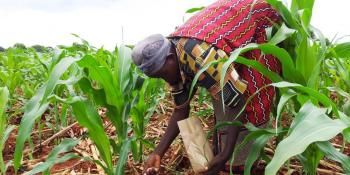Big Facts: Focus on Mitigation
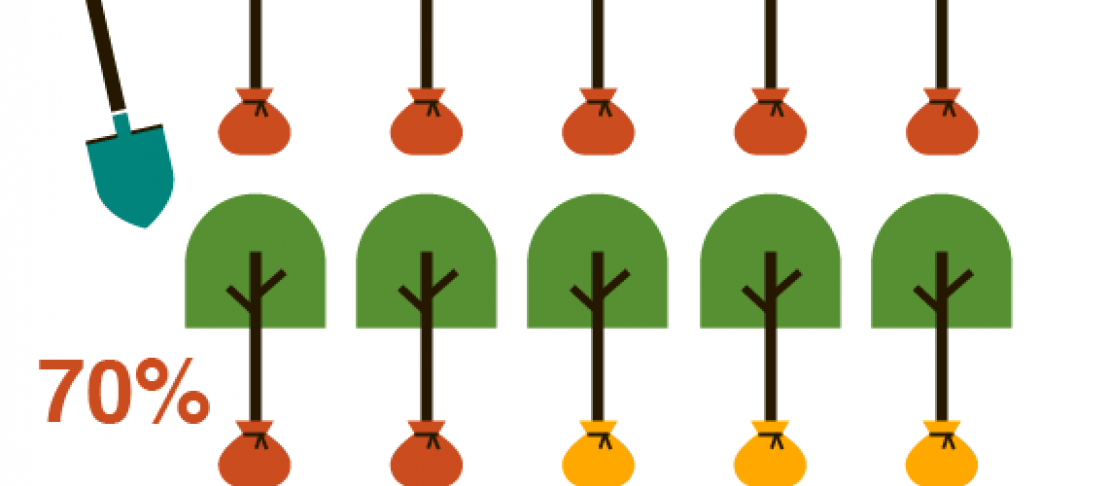
This story spotlights some of the Big Facts on Mitigation, and is part of a special blog series to complement the new Big Facts infographics website.
An important part of combating climate change is mitigating greenhouse gas (GHG) emissions. Opportunities for mitigating GHGs fall into three broad categories: (i) reducing emissions; (ii) enhancing removals; and (iii) avoiding (or displacing) emissions (IPCC, 2007). Agriculture is one sector that can achieve all three of these.
The overall potential to mitigate carbon (excluding biomass and fossil fuel offsets) in the agricultural sector is projected to be approximately 5,500-6,000 million tonnes of carbon dioxide equivalents (MtCO2e) per year by 2030 (Smith et al, 2008).Although, under a market based system, how much of that potential can actually be achieved will depend on the price of carbon. As the illustration below shows, the higher the price of carbon, the more likely we are to fulfil this potential.
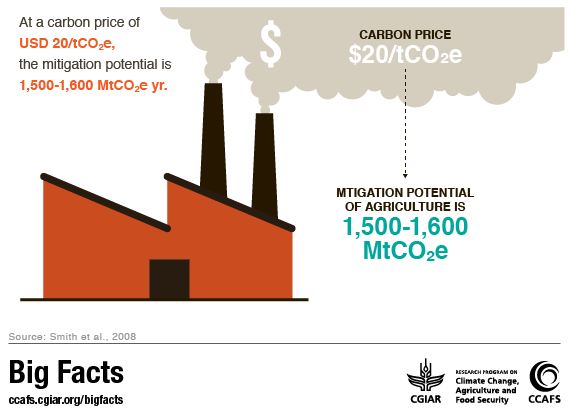
Reducing Emissions
As is shown in the Big Facts section on emissions agriculture and the food supply system contribute significant amounts of GHG emissions.
LEARN MORE: about emissions from food production
While large emissions do not necessarily equal large mitigation potential, there are already various avenues available to reduce emissions, some of which I highlight below.
In Latin America, North America and other areas with a significant production of livestock, one option is to change livestock diets in order to reduce the amount of methane livestock produce when digesting. In Europe, the greenhouse gas mitigation potential from the livestock sector is estimated to be in the order of 12-61% of total sector emissions in 2007 (Bellarby et al., 2012). Related to livestock and animal production, manure management has potential to reduce emissions, for example, by covering manure storage facilities, trapping the nitrous oxide, a potent GHG released by the manure.
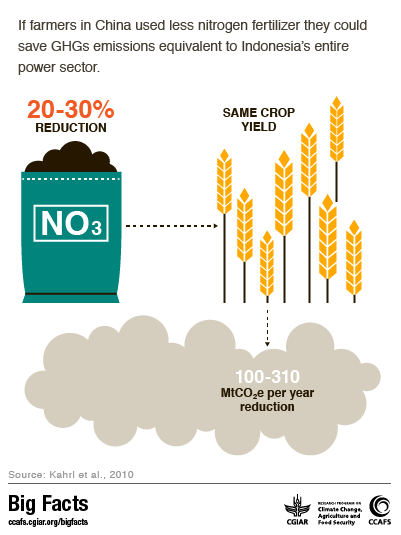
In South and South East Asia, rice production is the most widespread and economically important agricultural activity. However, as rice is often grown under submergence, meaning the fields are flooded for long periods of time, significant amounts of methane are released due to anaerobic (oxygen deprived) conditions in the rice field. Various options to reduce these emissions exist such as alternate wetting and drying, where the fields are drained and reflooded over the course of the growing season.
Enhancing removals
Enhancing removals means increasing the uptake of carbon in ecosystems and on agricultural land. Improved crop management will be key to achieving this. Through optimising nutrient use, the incorporation of nitrogen-fixing legumes into crop rotations, and a number of other ‘climate-smart’ practices, we can help mitigate the impacts of climate change.
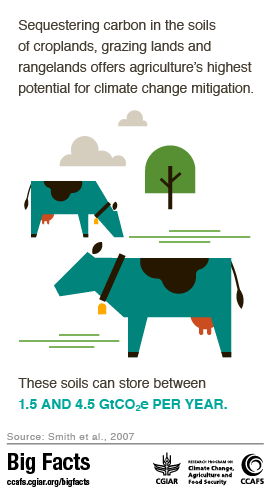
Other issues to consider include: pasture improvement; management of organic soils; restoration of degraded lands, for example, lands where overgrazing or deforestation has caused loss of soil organic matter; livestock management; manure management; and bioenergy (Smith et al., 2008). Indirect mitigation, for example through reforestation of areas no longer in use, also has significant potential. All of these practices are described in numerous articles, and a description of the benefits of some of the activities can be found on the Big Facts website.
Agriculture’s highest potential for climate change mitigation is to sequester carbon in the soils of croplands, grazing lands and rangelands. These soils are expected to be able to store between 1.5-4.5 GtCO2e per year (Smith et al., 2007; FAO, 2011) - though there is concern that these encouraging figures may be too good to be true.
Avoiding emissions
The most important action to avoid emissions is to slow down deforestation. Agriculture is responsible for about three fourths of all deforestation, and a 10% reduction in deforestation would reduce emissions by 300-600 MtCO2e per year from 2005-2030, significantly bringing down emissions from agriculture. It would cost about USD 0.4-1.7 billion per year to achieve this reduction (Kindermann et al. 2008), less than half of a percent of the total climate finance.
Reducing food waste also has significant potential to avoid emissions from agriculture. Around a third of all food produced is wasted every year (FAO, 2013), and as causes for this waste differ between low-, middle- and high-income countries, reducing emissions will require different mitigation approaches in different regions. In high-income countries, most food is wasted at retail and consumer levels, so efforts would have to target individuals and corporations, whereas in low-income countries, significant amount of food is wasted at farm level and in storage and transport. To combat this, investments in food infrastructure such as cold storage is needed.
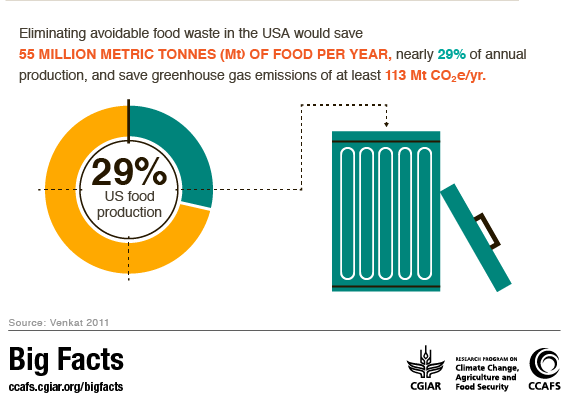
Changes in food consumption and waste may influence emissions from all stages of the food chain. To reduce emissions from consumption, the most important action is to reduce consumption of meat and dairy products. The elimination of all animal products from the human diet would save 7.8 GtCO2e per year in GHG emissions, more than the total yearly emissions of the entire United States - although such drastic action is not necessarily feasible or desired (Stehfest et al. 2009).
Looking forward
To combat climate change and limit the damage done, mitigation efforts will be extremely important. Agriculture must play a key role in this. Not only is agriculture’s contribution to the problem large, but its potential for mitigating is too. This short post is by no means an exhaustive overview of the various issues related to mitigation. I invite you to dig deeper into these issues on the Big Facts website where you will find numerous references are given, should you want to explore further.
HAVE YOUR SAY
Leave your ideas in the comments section below or send us an email.
Now you can get all the Big Facts on the links between climate change, agriculture and food security at ccafs.cgiar.org/bigfacts2014. The new site features over 100 stunning infographics that illustrate the most up-to-date, thoroughly researched information on these topics.
This story is part of a series focusing on the Big Facts on various topics and in different regions; join the conversation at ccafs.cgiar.org/blog and on twitter using #bigfacts

